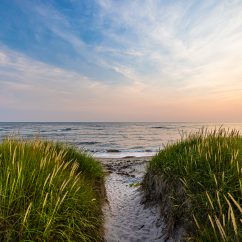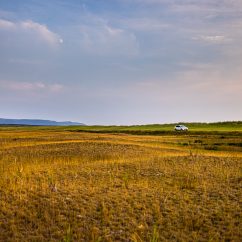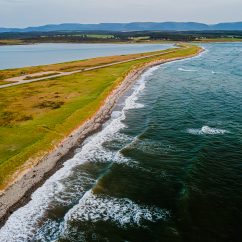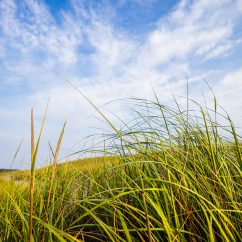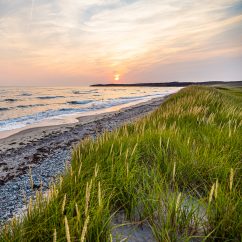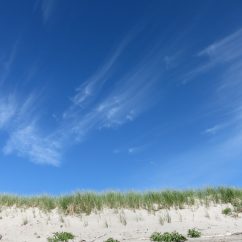The beautiful Codroy Valley features spectacular pastoral settings and is a wonderful spot to stop and take in all the southwest coast of Newfoundland has to offer. This provincial park’s greatest feature, though, has to be its breathtaking beach. This white sandy stretch separates the Atlantic Ocean from the Grand Codroy River. In the distance you can take in an incredible view of the Long Range Mountains. Here you can stroll the beach and listen to the sounds of the shore birds as the sun shimmers off the sea and sand alike. These beaches are the protected nesting grounds of the endangered Piping Plover.
Find out more about the park by visiting Natural History.
Photo Gallery
Activities
Angling
The nearby Grand Codroy River offers access to salmon and brook trout. Cast your fly and you should have no trouble hooking a big one. Landing it is another story! Angling is permitted within all provincial parks. Please note that all anglers require a provincial salmon license to fish scheduled inland waters and non-residents also require a trout license. Both can be purchased in most convenience stores. Visitors are responsible for following all regulations, to find out more, visit Fisheries and Oceans Canada.
Beach
This valley location has a large, beautiful sandy beach with the Grand Codroy River on one side and the Atlantic Ocean on the other. This is a lovely spot to relax, stroll and picnic. And a perfect place to plant your towel on a hot summer day. These beaches also act as an important nesting ground for the endangered Piping Plover. To avoid disturbing their nests and fragile eggs please pay close attention to signage, walk below the high water mark or on wet sand and keep your dogs leashed.
Bird Watching
The Codroy Valley will certainly keep the bird watcher busy. The area attracts diverse landbirds, waterfowl, shorebirds and seabirds. The sandy beach in this park is most known, however, for being a nesting ground for the endangered Piping Plover. Less than thirty pairs of this migratory shorebird frequent Newfoundland and Labrador between May and August each year. Disturbing their nests can result in adults abandoning a nest of chicks and/or prevent chicks from gaining the weight they need to survive. Be sure to pay close attention to signage, walk below the high water mark or on wet sand and keep your dogs leashed.
Dog Walking
Dogs are welcome in all provincial parks and Codroy Valley Provincial Park is no exception. And with this lovely beach and all that fresh, sea air it would be a real shame to leave your canine buddies behind. Please clean up after your pet. Visitors should also note that these beaches act as an important nesting ground for the endangered Piping Plover. To avoid disturbing their nests and fragile eggs please pay close attention to signage, walk below the high water mark or on wet sand and keep your dog leashed at all times.
Hiking and Walking
The beach here is just begging to be walked, your feet sinking into the warm sand as you make your way along the water. Waves lapping rhythmically against the shoreline as the sun glistens on the sea. You won’t need your hikers here, this is a place to stroll. Visitors should keep in mind that these beaches are an important nesting ground for the endangered Piping Plover. To avoid disturbing their nests and fragile eggs please pay close attention to signage, walk below the high water mark or on wet sand and keep your dog leashed at all times.
Photography
A beach like this is begging to be photographed and makes an excellent backdrop for the enthusiast photographer. Here, you won’t be long filling up an SD card. In fact, you might want to bring along a couple extra.
Picnics
After enjoying this beautiful beach, you’ll no doubt want to stop, catch your breath and soak up the natural beauty. Pack some snacks and treat yourself to a feast for the body and the soul.
Stargazing
When the sun sets the light show begins. The lack of artificial light around these parts means you’ll have no trouble spotting your favourite constellations as the stars twinkle and shine down from above. Bring along a telescope and take it all in.
Wildlife Watching
If it feels like you aren’t alone, you’re right! Look for evidence of the snowshoe hare, such as chewed twigs along pathways. Foxes have also been spotted in the area. And, of course, keep an eye out for the elusive and endangered Piping Plover as you walk the beach. The best time to experience wildlife in the park is in the morning or evening; keep quiet and keep your eyes peeled.
Prohibitions
Do Not Disturb
Please note that everything in a provincial park is protected; from the smallest rock to the largest tree. For that reason, introducing and/or removing any natural items is prohibited.
No Campfires
No Camping
No Cutting Trees
No Hunting
No Off-road Vehicles
Off-road vehicles include any motorized vehicles that are not legally permitted for use on provincial highways.
No Snowmobiles
Services
Cell Service
Cell service is available within the park.
Outhouse
Outhouse facilities are located in the park and are open seasonally.
Parking
There is parking available a short walk from the beach.
Natural History
Codroy Valley Provincial Park is located in the Codroy subregion of the Western Newfoundland Forest ecoregion. This subregion includes the Port au Port Peninsula and is characterized by a humid climate and a longer frost-free period. Landscapes here are dominated by rock barrens, especially limestone heaths supporting numerous species of rare and endangered plants
The beaches at Codroy Valley Provincial Park are a nesting ground for the endangered Piping Plover. Less than thirty pairs of this migratory shorebird frequent Newfoundland and Labrador between May and August each year. Disturbing their nests can result in adults abandoning a nest of chicks and/or prevent chicks from gaining the weight they need to survive. Be sure to pay close attention to signage, walk below the high water mark or on wet sand and keep your dogs leashed to protect this important visitor to Sandbanks Provincial Park.
For additional information on the natural history of this park in the Western Newfoundland Forest ecoregion, please refer to the Codroy subregion brochure.


